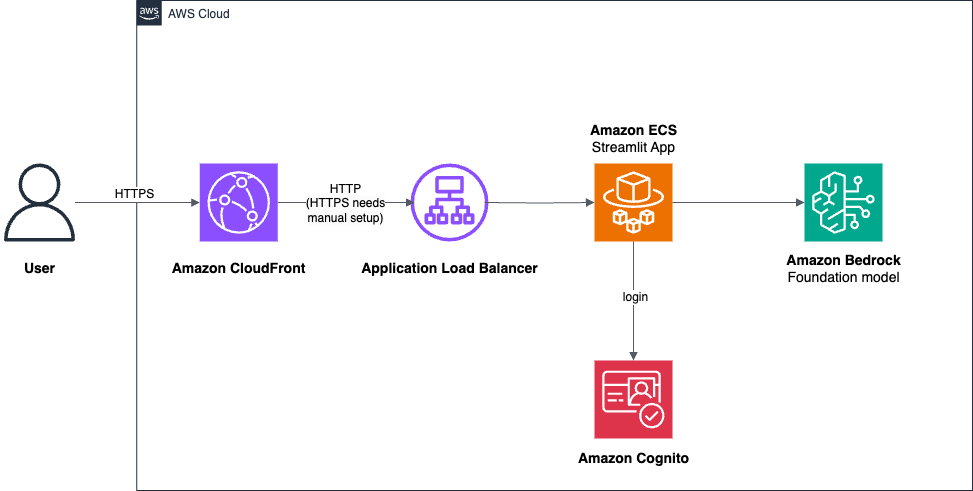AWS Machine Learning Blog
Category: Amazon Machine Learning
Integrate foundation models into your code with Amazon Bedrock
The rise of large language models (LLMs) and foundation models (FMs) has revolutionized the field of natural language processing (NLP) and artificial intelligence (AI). These powerful models, trained on vast amounts of data, can generate human-like text, answer questions, and even engage in creative writing tasks. However, training and deploying such models from scratch is […]
Build and deploy a UI for your generative AI applications with AWS and Python
AWS provides a powerful set of tools and services that simplify the process of building and deploying generative AI applications, even for those with limited experience in frontend and backend development. In this post, we explore a practical solution that uses Streamlit, a Python library for building interactive data applications, and AWS services like Amazon Elastic Container Service (Amazon ECS), Amazon Cognito, and the AWS Cloud Development Kit (AWS CDK) to create a user-friendly generative AI application with authentication and deployment.
Unearth insights from audio transcripts generated by Amazon Transcribe using Amazon Bedrock
In this post, we examine how to create business value through speech analytics with some examples focused on the following: 1) automatically summarizing, categorizing, and analyzing marketing content such as podcasts, recorded interviews, or videos, and creating new marketing materials based on those assets, 2) automatically extracting key points, summaries, and sentiment from a recorded meeting (such as an earnings call), and 3) transcribing and analyzing contact center calls to improve customer experience.
Best practices and lessons for fine-tuning Anthropic’s Claude 3 Haiku on Amazon Bedrock
In this post, we explore the best practices and lessons learned for fine-tuning Anthropic’s Claude 3 Haiku on Amazon Bedrock. We discuss the important components of fine-tuning, including use case definition, data preparation, model customization, and performance evaluation.
Track, allocate, and manage your generative AI cost and usage with Amazon Bedrock
Amazon Bedrock has launched a capability that organizations can use to tag on-demand models and monitor associated costs. Organizations can now label all Amazon Bedrock models with AWS cost allocation tags, aligning usage to specific organizational taxonomies such as cost centers, business units, and applications.
How Druva used Amazon Bedrock to address foundation model complexity when building Dru, Druva’s backup AI copilot
Druva enables cyber, data, and operational resilience for thousands of enterprises, and is trusted by 60 of the Fortune 500. In this post, we show how Druva approached natural language querying (NLQ)—asking questions in English and getting tabular data as answers—using Amazon Bedrock, the challenges they faced, sample prompts, and key learnings.
Create a generative AI–powered custom Google Chat application using Amazon Bedrock
AWS offers powerful generative AI services, including Amazon Bedrock, which allows organizations to create tailored use cases such as AI chat-based assistants that give answers based on knowledge contained in the customers’ documents, and much more. Many businesses want to integrate these cutting-edge AI capabilities with their existing collaboration tools, such as Google Chat, to […]
Unlock organizational wisdom using voice-driven knowledge capture with Amazon Transcribe and Amazon Bedrock
This post introduces an innovative voice-based application workflow that harnesses the power of Amazon Bedrock, Amazon Transcribe, and React to systematically capture and document institutional knowledge through voice recordings from experienced staff members. Our solution uses Amazon Transcribe for real-time speech-to-text conversion, enabling accurate and immediate documentation of spoken knowledge. We then use generative AI, powered by Amazon Bedrock, to analyze and summarize the transcribed content, extracting key insights and generating comprehensive documentation.
Empower your generative AI application with a comprehensive custom observability solution
In this post, we set up the custom solution for observability and evaluation of Amazon Bedrock applications. Through code examples and step-by-step guidance, we demonstrate how you can seamlessly integrate this solution into your Amazon Bedrock application, unlocking a new level of visibility, control, and continual improvement for your generative AI applications.
Automate Amazon Bedrock batch inference: Building a scalable and efficient pipeline
Although batch inference offers numerous benefits, it’s limited to 10 batch inference jobs submitted per model per Region. To address this consideration and enhance your use of batch inference, we’ve developed a scalable solution using AWS Lambda and Amazon DynamoDB. This post guides you through implementing a queue management system that automatically monitors available job slots and submits new jobs as slots become available.









